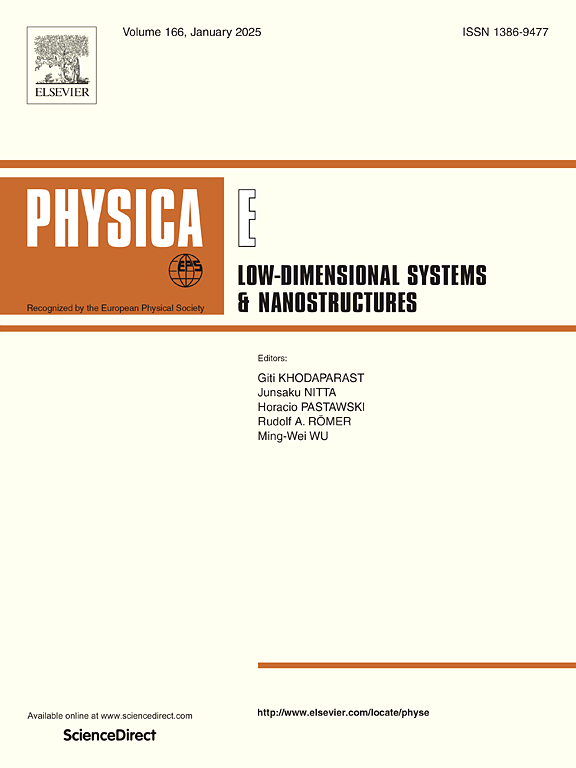揭示 InSb 纳米线网络中的连续束缚态
IF 2.9
3区 物理与天体物理
Q3 NANOSCIENCE & NANOTECHNOLOGY
Physica E-low-dimensional Systems & Nanostructures
Pub Date : 2024-11-07
DOI:10.1016/j.physe.2024.116145
引用次数: 0
摘要
连续谱中的束缚态(BIC)是一种奇异的局部态,尽管其能量位于连续谱中。自 1929 年被发现以来,在电荷输运实验中揭示这些奇异态的探索一直是凝聚态物理学中的一项积极追求。在这里,我们研究了弹道机制下 InSb 纳米线网络中的电荷传输,并将其作为观察和控制 BIC 出现的理想候选。我们发现,通过改变外加磁场和费米能,BIC 在电导中表现为独特的共振或反共振。我们系统地考虑了哈希标签状纳米线网络中不同的引线连接,找到了能增强与 BIC 出现相关的特征的最佳配置。最后,我们重点研究了 InSb 的 Rashba 自旋轨道相互作用对纳米线网络中出现 BIC 的影响。虽然这种相互作用通常对纳米线网络电导中的 BIC 起着不利作用,但它为将这些纳米结构用作自旋电子学的自旋过滤器提供了可能性。我们相信,这项工作将为在电荷传输实验中明确观测 BIC 以及开发先进的自旋电子器件铺平道路。本文章由计算机程序翻译,如有差异,请以英文原文为准。
Uncovering bound states in the continuum in InSb nanowire networks
Bound states in the continuum (BICs) are exotic, localized states even though their energy lies in the continuum spectra. Since its discovery in 1929, the quest to unveil these exotic states in charge transport experiments remains an active pursuit in condensed matter physics. Here, we study charge transport in InSb nanowire networks in the ballistic regime and subject to a perpendicular magnetic field as ideal candidates to observe and control the appearance of BICs. We find that BICs reveal themselves as distinctive resonances or antiresonances in the conductance by varying the applied magnetic field and the Fermi energy. We systematically consider different lead connections in hashtag-like nanowire networks, finding the optimal configuration that enhances the features associated with the emergence of BICs. Finally, the investigation focuses on the effect of the Rashba spin–orbit interaction of InSb on the occurrence of BICs in nanowire networks. While the interaction generally plays a detrimental role in the signatures of the BICs in the conductance of the nanowire networks, it opens the possibility to operate these nanostructures as spin filters for spintronics. We believe that this work could pave the way for the unambiguous observation of BICs in charge transport experiments and for the development of advanced spintronic devices.
求助全文
通过发布文献求助,成功后即可免费获取论文全文。
去求助
来源期刊
CiteScore
7.30
自引率
6.10%
发文量
356
审稿时长
65 days
期刊介绍:
Physica E: Low-dimensional systems and nanostructures contains papers and invited review articles on the fundamental and applied aspects of physics in low-dimensional electron systems, in semiconductor heterostructures, oxide interfaces, quantum wells and superlattices, quantum wires and dots, novel quantum states of matter such as topological insulators, and Weyl semimetals.
Both theoretical and experimental contributions are invited. Topics suitable for publication in this journal include spin related phenomena, optical and transport properties, many-body effects, integer and fractional quantum Hall effects, quantum spin Hall effect, single electron effects and devices, Majorana fermions, and other novel phenomena.
Keywords:
• topological insulators/superconductors, majorana fermions, Wyel semimetals;
• quantum and neuromorphic computing/quantum information physics and devices based on low dimensional systems;
• layered superconductivity, low dimensional systems with superconducting proximity effect;
• 2D materials such as transition metal dichalcogenides;
• oxide heterostructures including ZnO, SrTiO3 etc;
• carbon nanostructures (graphene, carbon nanotubes, diamond NV center, etc.)
• quantum wells and superlattices;
• quantum Hall effect, quantum spin Hall effect, quantum anomalous Hall effect;
• optical- and phonons-related phenomena;
• magnetic-semiconductor structures;
• charge/spin-, magnon-, skyrmion-, Cooper pair- and majorana fermion- transport and tunneling;
• ultra-fast nonlinear optical phenomena;
• novel devices and applications (such as high performance sensor, solar cell, etc);
• novel growth and fabrication techniques for nanostructures

 求助内容:
求助内容: 应助结果提醒方式:
应助结果提醒方式:


